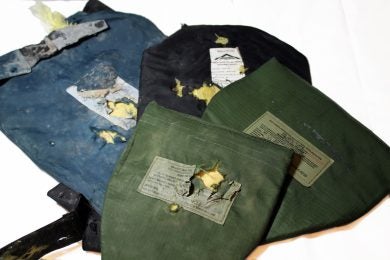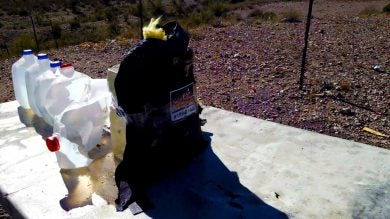You are probably well aware that even the very best soft armor is no help against rifle ammunition. Even relatively slow cartridges like 7.62x39mm and .300 AAC can still easily slice right through level IIIA armor. But what if several panels were layered on top of each other? Would it be enough to stop a rifle bullet? That is to say, obviously if you have enough layers of Kevlar you can stop any bullet but can you do it without looking like Ralphie’s brother in “A Christmas Story”? What if the shooter was far enough away? At some distance, it certainly could. At some distance, a cotton T-shirt could stop a bullet, but is it possible for a reasonable amount of soft armor to stop a rifle bullet at a speed that we can all agree is still truly a rifle bullet? To answer that question as definitively as is feasible, we shot a stack of four armor panels with a relatively slow .300 AAC load.

Level IIA, level IIIA, and two IBA groin protectors.

.300 AAC Sellier & Bellot 147 gr FMJ
The panels we had available were a Gall’s Lite level IIA, CATI level IIIA, and two groin protectors from IBA armor, which are approximately equivalent to level IIIA. This is, of course, a great deal more than any person is likely to be wearing at one time so if it can’t stop the threat, it seems safe to conclude that soft armor is ineffective against rifles under any reasonable conditions.
We chose .300 AAC Sellier & Bellot 147 gr FMJ because it is significantly slower than many other rifle rounds and velocity is the biggest factor that determines whether a projectile can defeat soft armor. It’s worth pointing out that at the muzzle, this load roughly approximates a 7.62x51mm M80 FMJ fired from an M14 at about 400 yards.
The results are pretty conclusive. As you can see in the high speed, the bullet slammed through all four armor panels, six inches of ballistic gel, and five gallon jugs of water. That means that it didn’t just barely get through; it had a great deal of hate left inside it, even after slicing through all that armor. While water does not compare perfectly with tissue, it tends to produce about 1.6 – 1.8 times the penetration observed in ballistic gel or soft tissue. That means that this bullet could still have passed through approximately 20 inches of tissue even after defeating the armor.

As noted above, there is certainly some distance at which this amount of armor would be successful in stopping a 7.62x51mm 147 gr bullet, but it appears to be quite a bit farther than 400 yards. To be fair, this much armor could be able to stop the .300 AAC load at a longer distance than seen in the test. Then again, it might not. Likewise, adding more armor would eventually be enough to stop it, too, but this is already more armor than a person could reasonably be expected to wear. To be sure, changing some of the factors could certainly have different results, but this seems to be fairly conclusive proof that no reasonable amount of soft armor can be depended upon to protect against rifles at any reasonable distance.
You can’t use a hammer to drive a screw and you shouldn’t depend on pistol armor to stop rifle threats. Use the right tool for the job. If you wear armor for a living or if it is part of your home defense or survival preparation plans, it is important for you to understand its capabilities. The level IIIA panel used in this test can stop virtually any handgun round, but we have seen that there just is not any practical way for soft armor to stop rifle rounds.
 Your Privacy Choices
Your Privacy Choices
